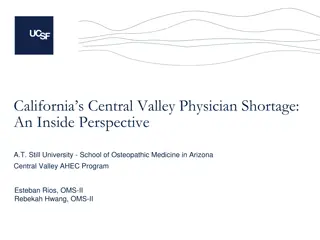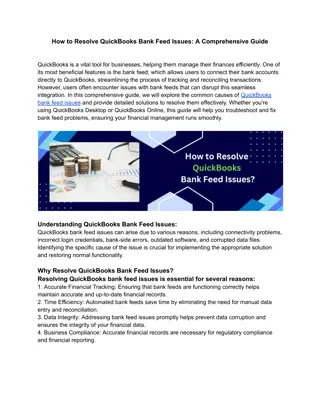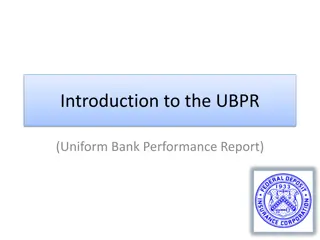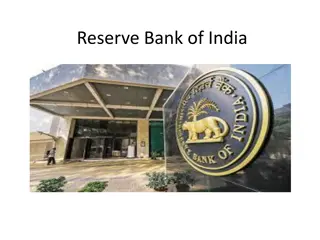Major Financial Implosion at Silicon Valley Bank
Uninsured deposits, risky investments, and poor risk management led to Silicon Valley Bank's downfall. With a focus on long-term bets on interest rates, the bank faced significant losses in its securities portfolio, resulting in a massive financial collapse in early 2023.
Download Presentation

Please find below an Image/Link to download the presentation.
The content on the website is provided AS IS for your information and personal use only. It may not be sold, licensed, or shared on other websites without obtaining consent from the author.If you encounter any issues during the download, it is possible that the publisher has removed the file from their server.
You are allowed to download the files provided on this website for personal or commercial use, subject to the condition that they are used lawfully. All files are the property of their respective owners.
The content on the website is provided AS IS for your information and personal use only. It may not be sold, licensed, or shared on other websites without obtaining consent from the author.
E N D
Presentation Transcript
A Brief Summary of the Silicon Valley Bank Implosion Timothy W. Koch Distinguished Professor Emeritus University of South Carolina & Past-President, Graduate School of Banking at Colorado
Which of the Following Statements are True? The failure of Silicon Valley Bank (SVB) was caused by: 1. The bank taking excessive interest rate risk 2. The bank taking excessive liquidity risk 3. Deregulation of financial markets (i.e., rollback of certain Dodd-Frank Act provisions) 4. Bad monetary policy 5. Excessive management focus on ESG (environmental, social, governance) and DEI (diversity, equity, inclusion) 6. Barney Frank serving as a Director of Signature Bank
Consider the bank or where you have your checking or savings account. Is each of your deposit accounts insured up to . . . a. $100,000 b. $250,000 c. Unlimited (all of it) d. Zero
SVB: Balance Sheet (Dec. 31, 2022) Assets (Avg. in billions) Liabilities + Equity (Avg. in billions) Interest earning Cash equivalents AFS securities HTM securities Loans (amort. cost) 70.3 Earning assets 209.2 Other assets (net ACL) 6.9 $ 14.7 28.8 95.4 Int. bearing checking MMDAs Other int. bearing dep. 5.3 Total int. bearing ST borrowings LT debt Total int. bearing liab $ 86.9 Non-int.bearing liab s Total liabilities $ 16.2 54.5 $ 76.0 7.4 3.5 116.8 $ 203.7 Stockholders equity 12.4 Total Assets 216.1 Total Liab. + Equity $216.1 NOTE: Equity / Total Assets = 5.74%
Major Financial Errors at SVB SVB s reported $60 billion in deposits in 2020 and almost $200 billion in 2022. [Many of these deposits had relatively short maturities.] At the time of failure, an estimated 90+% of the deposits were not FDIC-insured. SVB purchased large amounts of U.S. Treasury securities and longer-term mortgage-backed securities. [Many of these securities carried fixed interest rates and had long maturities.] SVB was essentially placing a bet that interest rates would not rise for a relatively long period of time and/or deposit customers would not withdraw their funds. But, rates did rise! SVB reported an after-tax loss of $1.8 billion when it sold AFS securities in early March 2023 while its holding company reported another $1 billion in securities losses in March 2023. The purpose for selling securities was to meet cash withdrawals. It announced a planned $2.25 billion stock raise. For most of 2022, SVB did not have a chief risk officer on staff. The CEO served this role.
Silicon Valley Banks Securities Portfolio From March 2022 to March 2023, the market value of Silicon Valley Bank s securities dropped by almost $34 billion, or 16% Commercial banks across the U.S. had an estimated $620 billion in unrealized losses on securities in early 2023
Unrealized Gains (Losses) on Investment Securities (All Banks) Held-to-Maturity Securities Available-for-Sale Securities 150 75 0 -75 -150 -225 -300 -375 -450 -525 -600 -675 -750 2008 2009 2010 2011 2012 2013 2014 2015 2016 2017 2018 2019 2020 2021 2022 Source: FDIC. Note: Insured Call Report filers only.
Some Companies that Held Deposits at SVB Roku ($487 million, 26% of firm s cash & equivalents) Roblox ($150 million) Circle ($3.3 billion) BlockFi ($227 million) Sangamo Therapeutics ($34 million) Rocket Lab USA ($38 million) Lending Club ($21 million) Compass Coffee Camp (privately owned NY toy firm) Juniper Networks ($10 million)
SVBs Customer Response: March 10th Many of SVB s customers were new tech start-ups, venture capitalists (VCs), and hedge fund partners Via the use of social media, customers withdrew approximately $42 billion in deposits on March 10 This is a classic RUN ON A BANK although it was prompted largely via communication by Twitter, et al On Sunday (March 12th), the FDIC guaranteed all deposits at SVB (and Signature Bank NY) Given fears of contagion, the Fed ultimately offered a Bank Term Funding Program (BTFP) whereby eligible borrowers could get cash advances up to 1 year maturity for a fixed-rate (1-year overnight swap rate + 0.10%) ,with no fees by pledging securities as collateral at par.
Community Banks lost some deposits, but the large regional banks lost the most (in dollars and %) Schwab reported deposit losses of $41 billion in 2023 Q1 (11%) State Street lost $17 billion in 2023 Q1 (5%) M&T lost $4.4 billion in 2023 Q1 (3%)
Uninsured Deposits as % of Domestic Deposits at U.S. Commercial Banks* Deposits at U.S. Commercial Banks* Uninsured Deposits as % of Domestic % % 50 50 45 40 40 35 30 30 25 20 20 15 10 10 5 0 0 2008 2011 2012 2013 2014 2015 2016 2017 2018 2019 2020 2021 2022 % * In 2008 the FDIC guaranteed all non-interest bearing accounts; in 2009 the insurance limit was increased to $250,000. From 1980-2007, the FDIC insurance limit was $100,000. Source: FDIC interest-bearing accounts; in 2009 the insurance limit was increased to $250,000 where it stands today * From 1980-2007, the FDIC insurance limit was $100,000; in 2008, the FDIC guaranteed all non-
Bank Term Funding Program: March 2023 Federal Reserve will make loans of up to one year in maturity Banks must pledge collateral, U.S. Treasuries, agency debt, mortgage- backed securities and other qualifying assets as collateral. These securities pledged will be valued at par. Rate charged is the one-year overnight index swap rate plus 10 basis points. The rate is fixed for the term of the advance on the day the loan is made. Bank may prepay the advance at any time without penalty. This holds even in the event that the bank wants to refinance the loan. There are no fees. The loans can be requested until at least March 11, 2024. As of June 7, 2023, the Federal Reserve had extended $100.2 billion of funding under this program. The program was terminated on March 11, 2024. At the end of April 2024, the total amount of advances under the program was $124.2 billion.
First Citizens Bancshares (FCNCA) Buys Loans & Deposits from Failed SVB Deal Announced on March 27, 2023 FCNCA took over $72 billion of loans (net of a $16.5 billion discount) Agreed to share any future losses or gains on these loans It did not assume any of SVB s $90 billion in securities Estimated cost to the FDIC is $20 billion FDIC provided a line of credit to First Citizens FCNCA s stock price increased by 47% in the first two hours of trading on March 27th
Immediate Editorial Commentary WSJ: this was a de facto bailout. The Administration has created moral hazard rewarding foolish risk-taking and bad management. NYT: Here we go again. Americans have every right to be furious, but the anger shouldn t be directed at the bailout, but at the regulatory failure that got us here. L.A. Times: Silicon Valley s small-government libertarians sure have chutzpah; tech titans who long-called regulators a drag on innovative spirits suddenly clamored for a federal rescue. Ron DeSantis: If there was a bank in Pennsylvania that serviced agriculture or small business, do you think they (small banks) would have been bailed out under similar circumstances? WSJ April 13
Treasury Secretary Janet Yellen said . . . The failures of SVB and Signature Bank are really a sign of strength, i.e., neither of these events triggered the worst case scenario a financial meltdown like we saw in 2007-2008. Responding to bank failures required substantial interventions to prevent a larger panic this means that more work must be done. When President Biden and I took office in 2021, we inherited a financial stability apparatus (FSOC) that had been decimated. In 2021, the FSOC identified three key priorities related to significant vulnerabilities in the financial system: - nonbank financial intermediation - climate-related financial risk - Treasury market resilience In 2022, the FSOC added a fourth key priority: - risks related to digital assets











